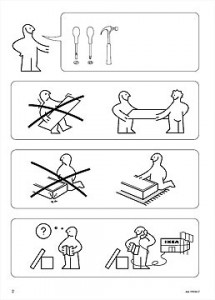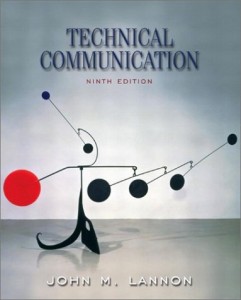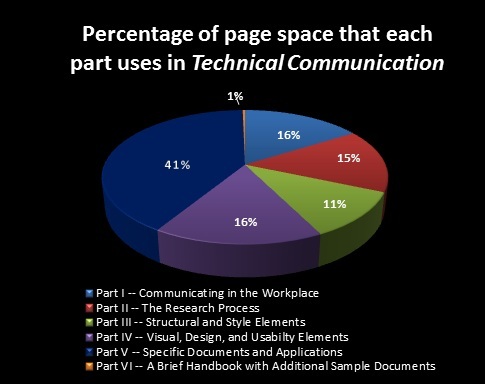Textbook Analysis: Technical Communication in the Twenty-First Century

Technical Communication in the Twenty-First Century (TCTC) was compiled by Sidney Dobrin, Christopher Keller and Chirstian Weisser. Their book focuses on technical communication through many lenses—they list 10 themes—, but the most ubiquitous themes are rhetoric (used explicitly), the writing process and connections to the work place.
Though the authors do not divide the book such, one could read the book as having four main sections: theoretical grounding, the writing process, types of documents, and an appendix with reference materials. Outside of the appendix, all chapters in every section follow the same format. The chapters begin with a section titled “Real People, Real Writing.” These sections present an interview about writing with a professional writer. The authors cast a wide net for writers, ranging from engineers to marketers to police officers. Chapters are punctuated with activities set off by graphics labeled “Explore,” “Analyze This,” and “In Your Experience.” Further, each chapter ends with overviews of the chapter, multiple case studies (some of which are accessible online, others are on an instructor’s DVD), and writing scenarios that revolve around particular themes such as “collaboration,” “ethics,” or “technology.” A Web site companion to the textbook includes PowerPoint overviews of each lesson, additional activities, and quizzes.
This is the first edition of the textbook. Currently, the textbook is in its second edition. According to the textbook’s accompanying Web site, the second edition added a chapter entitled “Technical Communication in a Transnational World.” The first edition does not address much about cross-cultural issues. The first edition contained a few strange design choices and what I would guess are design errors. But overall, the textbook seemed as though it would provide a strong grounding for a class. That said, with Amazon stocking only four new copies of the book, my guess is this is not a popular textbook.
Writing Process
TCTC organizes its writing process around what it terms the “Problem Solving Approach.” The approach has five elements: plan, research, draft, revise, distribute. Each element offers tasks (ie, under revise: “Test the usability of the document”) that will help develop the document. The authors are careful to note (and repeat) that the approach is not linear. They construe the process as requiring practice to know when to utilize the different elements of it. That said, the introduction to the process looks hierarchical. And at times in the documents chapters, the textbook runs through the process linearly. At other times, the authors insert a “PSA” graphic next to generalized discussion, which accentuates its nonlinearity. And, in at least one instance, the text explicitly shows how one might move from element to element nonlinearly to complete a task.
Rhetoric and Persuasion
This textbook, unlike others we have seen, addresses rhetoric explicitly. A brief look at the authors’s CVs reveals that each teaches classes in rhetoric or works for a rhetoric department. Chapter two of both editions introduces rhetorical terms and concepts. TCTC uses the rhetorical triangle, couched in workplace terms. The book also describes “exigency” and uses that as a basis for much of the work in the “plan” stage of the PSA. It then connects other elements of the PSA to ideas of audience, author and text. Unstated but present are allusions to the rhetorical cannon: questions for the student to answer about organization stands in for arrangement, questions about distribution media for delivery. While the book doesn’t shy away from rhetorical terminology as other books seem to do, the terms only dominate in chapter two.
Document Design and Visuals
Chapters 7 and 8 of the textbook (chapters 8 and 9 of the latest edition) deal directly with design. Chapter 7 uses the term “visual rhetoric” and defines numerous types of graphics and images, two elements the text terms as distinct. Additionally, the text provides theoretical guidelines for visuals. Chapter 8 introduces what the editors call “elements” and “principles” “document architecture.” These include ideas such as balance and connection along with typography and white space. These two chapters are also quite visual heavy; I would estimate these chapters contain more visuals than text and the authors work to give numerous examples of successful and unsuccessful document designs for the various elements and principles they define.
Style and Tone
TCTC addresses style and tone throughout, both in terms of content and the implications of visuals on style and tone. The critical focus tends to be on using tone as a way to demonstrate professionalism. Both in the appearance and content, the editors provide examples of texts that show appropriate versus inappropriate tones.
Document Genres and Types of Writing
The textbook uses 12 chapters to address genres and types of writings. They begin with documents that nearly everyone will have to write: emails, letters, memos, resumes, cover letters, etc. Then, the editors move to increasingly complex or specialized documents: Websites, formal reports, manuals and so on. Each section has many pictures of examples and each section defines many subordinate types of documents. Additionally, the authors note the variety of ethical and technological issues that might accompany particular documents.
Research and Writing Technologies
In the opening chapters, the authors tend to take a descriptive stance on technologies: this is what is available; this is how you may use it. This leaves something to be desired because the book doesn’t outline specific uses. However, the editors remedy this in the document genres, showing how different technologies may benefit a particular text. Additionally, choosing a technology or medium for distribution figures into the textbook’s “Problem Solving Strategy.”
Ethics
I also wanted to address ethics because the authors thought ethical discussions quite important. Ethics is mentioned twice in the “Problem Solving Approach,” and each specific document chapter has some discussion fo ethics.


